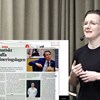bringing
Donatella Della Porta: Antiausterity protests in Europe and beyond: bringing capitalist back into social movement studies
Donatella Della Porta, Professor of Sociology at Scuola normale superiore, and Director of the Centre of Social Movements Studies. ABSTRACTSocial movement studies have developed a useful kit of concept
Katharina Berndt Rasmussen: Bridging Gaps - A Theory of Discrimination
Venue: Institutet för framtidsstudier, Holländargatan 13, 4th floor, Stockholm, or online. Research seminar with Katharina Berndt Rasmussen, PhD. in Philosophy.Register here >Abstract Disputes about d

Katharina Berndt Rasmussen: Bridging Gaps - A Theory of Discrimination
Research seminar with Katharina Berndt Rasmussen, PhD. in Philosophy. Disputes about discrimination surface time and again in the public debate: Is there such a thing as ”reverse discrimination” or ”S
Activation in Integrated Services? Bridging Social and Employment Services in European Countries
This paper studies how the new, integrated employment and social services look like with respect to government structures, e.g. shifts of responsibility upwards or downwards for both groups and how en
POSTPONED UNTIL OCTOBER 16: Katharina Berndt Rasmussen: Bridging Gaps - A Theory of Discrimination
Venue: Institutet för framtidsstudier, Holländargatan 13, 4th floor, Stockholm, or online. Research seminar with Katharina Berndt Rasmussen, PhD. in Philosophy.AbstractDisputes about discrimination surf
Chapter 14 Collaborative Future-Making: Bridging the Everyday and the Global Political Economy of Automated Health
Fors, Vaike, Berg, Martin and Brodersen, Meike. The De Gruyter Handbook of Automated Futures: Imaginaries, Interactions and Impact, Berlin, Boston: De Gruyter, 2024. Abstract Health services and medical
Biased grades? Changes in grading after a blinding of examinations reform
in: Journal of Assessment and Evaluation in Higher Education 45, 292-303. AbstractGroup differences in average grades prior to and after a step-wise introduction of blinded examinations at Stockholm Un
Predicting Alcohol Misuse Among Australian 19-Year-Olds from Adolescent Drinking Trajectories
Substance Use & Misuse, doi.org/10.1080/10826084.2018.1517172. AbstractBackground: Alcohol use in adolescence predicts future alcohol misuse. However, the extent to which different patterns of adol This study investigated how adolescent trajectories of alcohol consumption during the school years predict alcohol misuse at age 19 years. Data were drawn from 707 students from Victoria, Australia, longitudinally followed for 7 years. Five alcohol use trajectories were identified based on the frequency of alcohol use from Grade 6 (age 12 years) to Grade 11 (age 17 years). At age 19 years, participants completed measures indicating Heavy Episodic Drinking (HED), dependency – Alcohol Use Disorders Identification Test (AUDIT) and social harms. At 19 years of age, 64% of participants reported HED, 42% high AUDIT scores (8+), and 23% social harms. Participants belonging to a steep escalator trajectory during adolescence had twice the odds at 19 years of age of high AUDIT scores and social harms, and three times greater odds of HED than participants whose alcohol use slowly increased. Stable moderate consumption was also associated with an increased risk of HED compared to slowly increasing use. Abstinence predicted a reduced likelihood of all forms of misuse at 19 years of age compared to slowly increased alcohol use. Trajectories of drinking frequency during adolescence predict alcohol misuse at age 19 years. Although rapid increasing use presents the greatest risk, even slowly increasing drinking predicts increased risk compared to abstinence. The findings indicate that alcohol policies should recommend nonuse and reduced frequency of use during adolescence.
Tourism and the Globalization of Emotions. The Intimate Economy of Tango.
[Reissue] New York: Routledge. Throughout the chapters, the author assesses how, in an explosive economic and political context, people's emotional lives intermingle with a tourism industry that has fo

Moral uncertainty
Participants: Krister Bykvist, Toby Ord and William MacAskill. Very often we are uncertain about what we ought, morally, to do. We do not know how to weigh the interests of animals against humans, how








